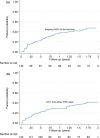Stopping and restarting PrEP and loss to follow-up among PrEP-taking men who have sex with men and transgender women at risk of HIV-1 participating in a prospective cohort study in Kenya
- PMID: 35088511
- PMCID: PMC9276557
- DOI: 10.1111/hiv.13237
Stopping and restarting PrEP and loss to follow-up among PrEP-taking men who have sex with men and transgender women at risk of HIV-1 participating in a prospective cohort study in Kenya
Abstract
Objective: To assess frequency and predictors of switching between being on and off PrEP and being lost to follow-up (LTFU) among men who have sex with men (MSM) and transgender women (TGW) with access to PrEP services in Sub-Saharan Africa.
Methods: This was a prospective cohort study of MSM and TGW from coastal Kenya who initiated daily oral PrEP from June 2017 to June 2019. Participants were followed monthly for HIV-1 testing, PrEP refill, risk assessment and risk reduction counselling. Follow-up was censored at the last visit before 30 June 2019, or the last HIV-1-negative visit (for those with HIV-1 seroconversion), whichever occurred first. We estimated transition intensities (TI) and predictors of switching: (i) between being off and on PrEP; and (ii) from either PrEP state and being LTFU (i.e. not returning to the clinic for > 90 days) using a multi-state Markov model.
Results: In all, 134 participants starting PrEP were followed for a median of 20.3 months [interquartile range (IQR): 7.7-22.1]. A total of 49 (36.6%) people stopped PrEP 73 times [TI = 0.6/person-year (PY), 95% confidence interval (CI): 0.5-0.7] and, of these, 25 (51.0%) restarted PrEP 38 times (TI = 1.2/PY, 95% CI: 0.9-1.7). In multivariable analysis, stopping PrEP was related to anal sex ≤ 3 months, substance-use disorder and travelling. Restarting PrEP was related to non-Christian or non-Muslim religion and travelling. A total of 54 participants were LTFU: on PrEP (n = 47, TI = 0.3/PY, 95% CI: 0.3-0.5) and off PrEP (n = 7, TI = 0.2/PY, 95% CI: 0.1-0.4). In multivariable analysis, becoming LTFU while on PrEP was associated with secondary education or higher, living in the area for ≤ 1 year, residence outside the immediate clinic area and alcohol-use disorder.
Conclusions: Switching between being on and off PrEP or becoming LTFU while on PrEP was frequent among individuals at risk of HIV-1 acquisition. Alternative PrEP options (e.g. event-driven PrEP) may need to be considered for MSM and TGW with PrEP-taking challenges, while improved engagement with care is needed for all MSM and TGW regardless of PrEP regimen.
Keywords: HIV-1; Kenya; MSM; PrEP; lost to follow-up; predictors.
© 2022 The Authors. HIV Medicine published by John Wiley & Sons Ltd on behalf of British HIV Association.
Conflict of interest statement
MP reports grants from Gilead sciences, Roche, AbbVie and MSD during the conduct of the study.
Figures




Similar articles
-
Risk factors for loss to follow-up among at-risk HIV negative men who have sex with men participating in a research cohort with access to pre-exposure prophylaxis in coastal Kenya.J Int AIDS Soc. 2020 Oct;23 Suppl 6(Suppl 6):e25593. doi: 10.1002/jia2.25593. J Int AIDS Soc. 2020. PMID: 33000889 Free PMC article.
-
PrEP interest and HIV-1 incidence among MSM and transgender women in coastal Kenya.J Int AIDS Soc. 2019 Jun;22(6):e25323. doi: 10.1002/jia2.25323. J Int AIDS Soc. 2019. PMID: 31194291 Free PMC article.
-
"I wish to remain HIV negative": Pre-exposure prophylaxis adherence and persistence in transgender women and men who have sex with men in coastal Kenya.PLoS One. 2021 Jan 19;16(1):e0244226. doi: 10.1371/journal.pone.0244226. eCollection 2021. PLoS One. 2021. PMID: 33465090 Free PMC article.
-
Demand creation and retention strategies for oral pre-exposure prophylaxis for HIV prevention among men who have sex with men and transgender women: a systematic review and meta-analysis.BMC Infect Dis. 2023 Nov 14;23(1):793. doi: 10.1186/s12879-023-08693-z. BMC Infect Dis. 2023. PMID: 37964202 Free PMC article.
-
Pre-Exposure Prophylaxis for HIV Prevention in Women: Current Status and Future Directions.Drugs. 2019 Aug;79(12):1263-1276. doi: 10.1007/s40265-019-01143-8. Drugs. 2019. PMID: 31309457 Review.
Cited by
-
Peer-Delivered HIV Self-Testing, Sexually Transmitted Infection Self-Sampling, and Pre-exposure Prophylaxis for Transgender Women in Uganda: A Randomized Trial.J Acquir Immune Defic Syndr. 2024 Oct 1;97(2):125-132. doi: 10.1097/QAI.0000000000003471. J Acquir Immune Defic Syndr. 2024. PMID: 39250646 Free PMC article. Clinical Trial.
-
Attrition from Care and Barriers to PrEP Use Among Key Populations in Kinshasa, DRC: A Multiple Methods Study.AIDS Behav. 2025 Jul 7. doi: 10.1007/s10461-025-04809-5. Online ahead of print. AIDS Behav. 2025. PMID: 40622511
-
Healthcare access and barriers to utilization among transgender and gender diverse people in Africa: a systematic review.BMC Glob Public Health. 2024;2(1):44. doi: 10.1186/s44263-024-00073-2. Epub 2024 Jun 27. BMC Glob Public Health. 2024. PMID: 38948028 Free PMC article. Review.
-
Restarting pre-exposure prophylaxis (PrEP) for HIV: a systematic review and meta-analysis.EClinicalMedicine. 2024 May 17;72:102647. doi: 10.1016/j.eclinm.2024.102647. eCollection 2024 Jun. EClinicalMedicine. 2024. PMID: 38800799 Free PMC article.
-
Participatory development of the Shauriana program to integrate sexual health and mental health support for young gay and bisexual men and other men who have sex with men in Kenya.Adv Glob Health. 2025;4(1):2442813. doi: 10.1525/agh.2025.2442813. Epub 2025 Mar 6. Adv Glob Health. 2025. PMID: 40296878 Free PMC article.
References
-
- WHO . WHO expands recommendation on oral pre‐exposure prophylaxis of HIV infection (PrEP) 2015. https://apps.who.int/iris/bitstream/handle/10665/197906/WHO_HIV_2015.48_.... Accessed July 28, 2020.
-
- National AIDS & STI Control Program (NASCOP) MoH . Guidelines on Use of Antiretroviral Drugs for Treating and Preventing HIV Infection in Kenya. August 2018 ed. NASCOP; 2018.
-
- AVAC . PrEPWatch: AVAC; 2020. https://www.prepwatch.org/. Accessed July 28, 2020.
-
- Makobu Kimani EvdE, Oscar C, Fauz I, et al. Pre‐exposure prophylaxis adherence and persistence in Kenyan MSM and transgender women. 2020 Conference on Retroviruses and Opportunistic Infections (CROI); Boston, USA; Mar 08‐11, 2020 Abstract 0878.
Publication types
MeSH terms
Grants and funding
LinkOut - more resources
Full Text Sources
Medical
Miscellaneous

